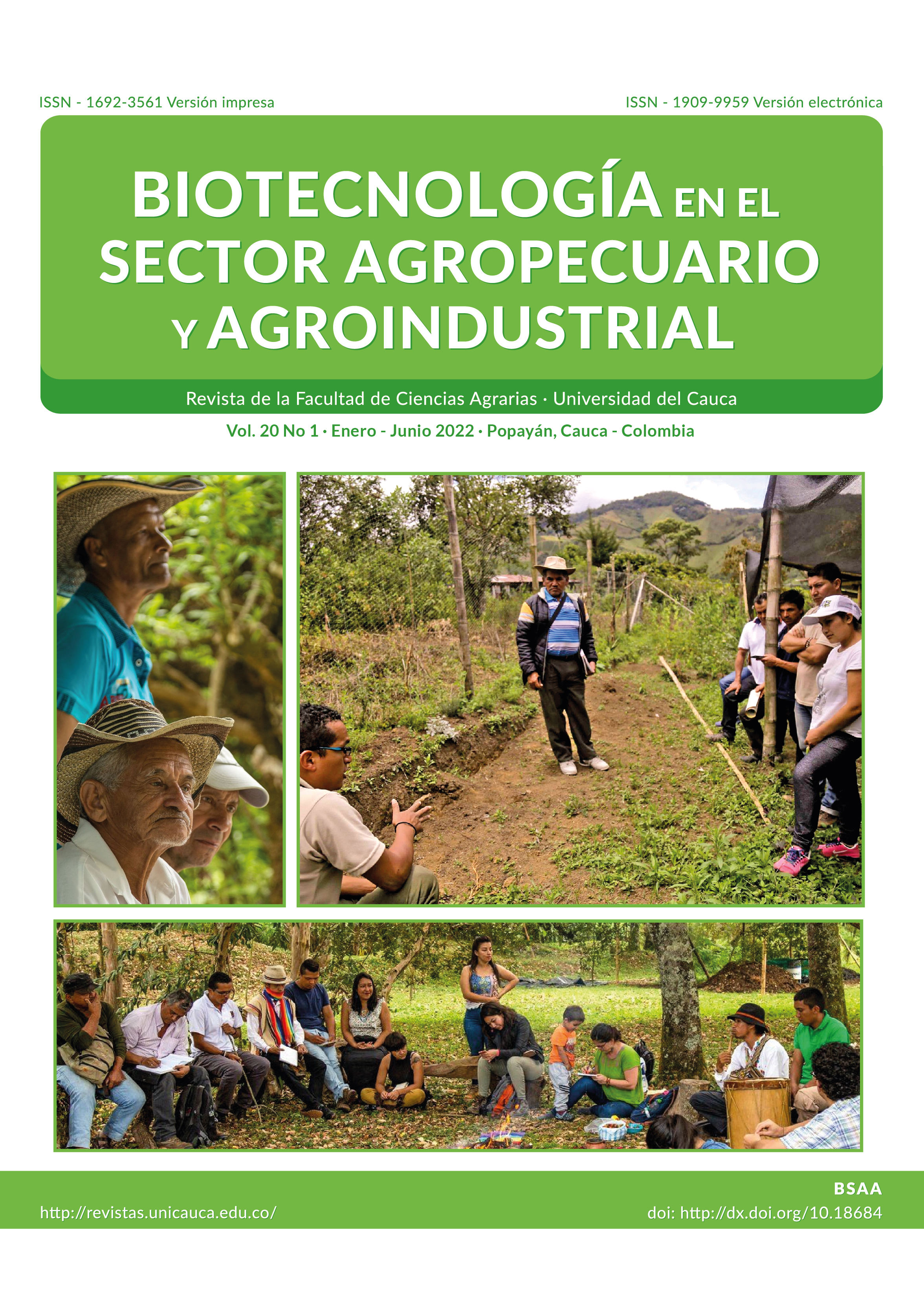Obtención de nanoemulsiones de Cúrcuma longa l. y su aplicación en bebida acuosa
Resumen
La curcumina contrarresta diversas patologías como el cáncer y enfermedades neurodegerativas. Sin embargo, su solubilidad es baja en soluciones acuosas limitando su aplicación. Este estudio busca obtener una emulsión estable aceite en agua (O/W) a base de oleorresina de Cúrcuma longa (ORC) y aplicarla en una bebida acuosa como alternativa al uso de colorantes artificiales como la tartrazina. Se formularon dos tipos de emulsión: con oleorresina (EORC) y curcumina comercial 75% (ECC), se caracterizaron mediante porcentaje de retención de curcumina (%CR), contenido de fenoles totales (TPC), estabilidad física y tamaño de partícula mediante microscopía electrónica de trasmisión (TP), luego se aplicaron en bebidas acuosas, caracterizadas por % CR, TP y turbidez (T). Se obtuvieron nanoemulsiones estables para EORC y ECC con TP de 10,201 nm y 13,847 nm, %CR de 67,136 y 81,991% y TPC de 35,466 y 36,128 mg EAG/L emulsión respectivamente. En las bebidas, el %CR para EORC y ECC fue de 80,014 y 20,048%, TP de 5,732 nm y 5,309 nm respectivamente. La bebida con EORC presentó mayor turbidez en comparación a ECC y tartrazina (control). Se obtuvieron bebidas estables en el tiempo, pero EORC presentó mayor %CR, la cual puede ser una alternativa potencial como colorante y antioxidante en bebidas acuosas.
Descargas
Disciplinas:
alimentos y bebidas, ingeniería, compuestos bioactivosLenguajes:
Español; CastellanoReferencias bibliográficas
ADITYA, N.P.; ADITYA, S.; YANG, H.J.; KIM, H.W.; PARK, S.O.; LEE, J.; KO, S. Curcumin and Catechin Co-Loaded Water-in-Oil-in-Water Emulsion and Its Beverage Application. Journal of Functional Foods, v. 15, 2015, p. 35–43.https://doi.org/10.1016/j.jff.2015.03.013
AHMED, K.; LI, Y.; MCCLEMENTS, D.J.; XIAO, H. Nanoemulsion- and Emulsion-Based Delivery Systems for Curcumin: Encapsulation and Release Properties. Food Chemistry, v. 132, n. 2, 2012, p. 799807.https://doi.org/10.1016/j.foodchem.2011.11.039
ARAIZA-CALAHORRA, A.; AKHTAR, M.; SARKAR, A. Recent Advances in Emulsion-Based Delivery Approaches for Curcumin: From Encapsulation to Bioaccessibility. Trends in Food Science and Technology, v. 71, 2018, p. 155–169.https://doi.org/10.1016/j.tifs.2017.11.009
ASWATHANARAYAN, J.B.; VITTAL, R.R. Nanoemulsions and Their Potential Applications in Food Industry. Frontiers in Sustainable Food Systems, v. 3, 2019, p. 1–21.https://doi.org/10.3389/fsufs.2019.00095
AZMI, N.A.N.; ELGHARBAWY, A.A.M.; MOTLAGH, S.R.; SAMSUDIN, N.; SALLEH, H.M. Nanoemulsions: Factory for Food, Pharmaceutical and Cosmetics. Processes, v. 7, n. 9 2019, p. 617.https://doi.org/10.3390/pr7090617
BAGHERI, H.; GHASEMI, F.; BARRETO, G.E.; RAFIEE, R.; SATHYAPALAN, T.; SAHEBKAR, A. Effects of Curcumin on Mitochondria in Neurodegenerative Diseases. BioFactors, v. 46, n. 1, 2020, p. 5–20.https://doi.org/10.1002/biof.1566
BHATT, D.; VYAS, K.; SINGH, S.; JOHN, P.J.; SONI, I. Tartrazine Induced Neurobiochemical Alterations in Rat Brain Sub-Regions. Food and Chemical Toxicology, v. 113, 2018, p. 322–327.https://doi.org/10.1016/j.fct.2018.02.011
BONCIU, E.; ROSCULETE, E.; ROSCULETE, C.A. The clastogenic effect of tartrazine, a synthetic yellow dye, in plant meristematic tissues. Annals of the University of Craiova - Agriculture, Montanology, Cadastre Series. v. 49, 2019.
http://anale.agro-craiova.ro/index.php/aamc/article/view/876
DANAFAR, H.; SHARAFI, A.; KHEIRI, S.; MANJILI, H.K. CoDelivery of Sulforaphane and Curcumin with Pegylated Iron Oxide-Gold Core Shell Nanoparticles for Delivery to Breast Cancer Cell Line. Iranian Journal of Pharmaceutical Research, v. 17, n. 2, 2018, p. 480–494. https://doi.org/10.2g2037/ijpr.2018.2239
GHAYOUR, N.; HOSSEINI, S.M.H.; ESKANDARI, M.H.; ESTEGHLAL, S.; NEKOEI, A.R.; HASHEMI-GAHRUIE, H.; TATAR, M.; NAGHIBALHOSSAINI, F. Nanoencapsulation of Quercetin and Curcumin in Casein-Based Delivery Systems. Food Hydrocolloids, v. 87, 2019, p. 394–403.https://doi.org/10.1016/j.foodhyd.2018.08.031
GORDON, O.N.; LUIS, P.B.; ASHLEY, R.E.; OSHEROFF, N.; SCHNEIDER, C. Oxidative Transformation of Demethoxy and Bisdemethoxycurcumin: Products, Mechanism of Formation, and Poisoning of Human Topoisomerase IIα. Chemical Research in Toxicology, v. 28, n. 5, 2015, p. 989–996.https://doi.org/10.1021/acs.chemrestox.5b00009
GRANATO, D.; BARBA, F.J.; KOVAČEVIĆ, D.B.; LORENZO, J.M.; CRUZ, A.G.; PUTNIK, P. Functional Foods: Product Development, Technological Trends, Efficacy Testing, and Safety. Annual Review of Food Science and Technology, v. 11, n.1, 2020, p. 93-118.https://doi.org/10.1146/annurev-food-032519-051708
JAKUBEK, M.; KEJÍK, Z.; KAPLÁNEK, R.; HROMÁDKA, R.; ŠANDRIKOVÁ, V.; SÝKORA, D.; ANTONYOVÁ, V.; URBAN, M.; DYTRYCH, P.; MIKULA, I.; MARTÁSEK, P.; KRÁL, V. Strategy for Improved Therapeutic Efficiency of Curcumin in the Treatment of Gastric Cancer. Biomedicine and Pharmacotherapy, v. 118, 2019.https://doi.org/10.1016/j.biopha.2019.109278
JAMWAL, R. Bioavailable Curcumin Formulations: A Review of Pharmacokinetic Studies in Healthy Volunteers. Journal of Integrative Medicine, v. 16, n. 6, 2018, p. 367–374.https://doi.org/10.1016/j.joim.2018.07.001
KHARAT, M.; DU, Z.; ZHANG, G.; MCCLEMENTS, D.J. Physical and Chemical Stability of Curcumin in Aqueous Solutions and Emulsions: Impact of PH, Temperature, and Molecular Environment. Journal of Agricultural and Food Chemistry, v. 65, n. 8, 2017, p. 1525–1532.https://doi.org/10.1021/acs.jafc.6b04815
KHARAT, M.; ZHANG, G.; MCCLEMENTS, D.J. Stability of Curcumin in Oil-in-Water Emulsions: Impact of Emulsifier Type and Concentration on Chemical Degradation. Food Research International, v. 111, 2018, p. 178–186.https://doi.org/10.1016/j.foodres.2018.05.021
KIM, S.O.; HA, T.V.A.; CHOI, Y.J.; KO, S. Optimization of Homogenization-Evaporation Process for Lycopene Nanoemulsion Production and Its Beverage Applications. Journal of Food Science, v. 79, n. 8, 2014, p. 12–14.https://doi.org/10.1111/1750-3841.12472
KUMAR, M.; BISHNOI, R.S.; SHUKLA, A.K.; JAIN, C.P. Techniques for Formulation of Nanoemulsion Drug Delivery System: A Review. Preventive Nutrition and Food Science, v. 24, n. 3, 2019, p. 225–234.https://doi.org/10.3746/pnf.2019.24.3.225
LI, M.; NGADI, M.O.; MA, Y. Optimization of Pulsed Ultrasonic and Microwave-Assisted Extraction for Curcuminoids by Response Surface Methodology and Kinetic Study. Food Chemistry, v. 165, 2014, p. 29–34.https://doi.org/10.1016/j.foodchem.2014.03.115
LIU, Q.; HUANG, H.; CHEN, H.; LIN, J.; WANG, Q. Food-Grade Nanoemulsions: Preparation, Stability and Application in Encapsulation of Bioactive Compounds. Molecules, v. 24, n. 23, 2019, p. 1–37.https://doi.org/10.3390/molecules24234242
LU, P.S.; INBARAJ, B.S.; CHEN, B.H. Determination of Oral Bioavailability of Curcuminoid Dispersions and Nanoemulsions Prepared from Curcuma longa Linnaeus. Journal of the Science of Food and Agriculture, v. 98, n. 1, 2018, p. 51–63.https://doi.org/10.1002/jsfa.8437
MACHADO, A.P.D.F.; PASQUEL-REÁTEGUI, J.L.; BARBERO, G.F.; MARTÍNEZ, J. Pressurized Liquid Extraction of Bioactive Compounds from Blackberry (Rubus Fruticosus L.) Residues: A Comparison with Conventional Methods. Food Research International, v. 77, 2015, p. 675–683. https://doi.org/10.1016/j.foodres.2014.12.042
MARTÍNEZ-GUERRA, J.; PALOMAR-PARDAVÉ, M.; ROMERO-ROMO, M.; CORONA-AVENDAÑO, S.; ROJAS-HERNÁNDEZ, A.; RAMÍREZ-SILVA, M.T. New Insights on the Chemical Stability of Curcumin in Aqueous Media at Different PH: Influence of the Experimental Conditions. International Journal of Electrochemical Science, v. 14, n. 6, 2019, p. 5373–5385.https://doi.org/10.20964/2019.06.24
MC CLEMENTS, D.J.; JAFARI, S.M. General Aspects of Nanoemulsions and Their Formulation. Nanoemulsions: Formulation, Applications, and Characterization, 2018, p. 3–20.https://doi.org/10.1016/B978-0-12-811838-2.00001-1
PATIL, S.; RANVEER, R.C.; DEBAJE, P.P.; KADAM, J.H.; SAHOO, A.K. Ultrasound Assisted Extraction of Curcumin. Asian J. Dairy & Food Res, v. 37, n. 3, 2018, p. 250–252.https://doi.org/10.18805/ajdfr.DR-1356
PATIL, S.S.; BHASARKAR, S.; RATHOD, V.K. Extraction of Curcuminoids from Curcuma longa: Comparative Study between Batch Extraction and Novel Three Phase Partitioning. Preparative Biochemistry and Biotechnology, v. 49, n. 4, 2019, p. 407–418. https://doi.org/10.1080/10826068.2019.1575859
SANDEEP, I.S.; DAS, S.; NAYAK, S.; MOHANTY, S. Chemometric Profile of Curcuma longa L. Towards Standardization of Factors for High Essential Oil Yield and Quality. Proceedings of the National Academy of Sciences India Section B - Biological Sciences, v. 88, n. 3, 2018, p. 949–957.https://doi.org/10.1007/s40011-016-0831-y
SINGLETON, V.L.; ORTHOFER, R.; LAMUELA-RAVENTÓS, R.M. Analysis of Total Phenols and Other Oxidation Substrates and Antioxidants by Means of Folin-Ciocalteu Reagent. Methods in Enzymology, v. 299, 1999, p. 152–178.https://doi.org/10.1016/S0076-6879(99)99017-1
SUGUMAR, S.; MUKHERJEE, A.; CHANDRASEKARAN, N. Nanoemulsion Formation and Characterization by Spontaneous Emulsification: Investigation of Its Antibacterial Effects on Listeria monocytogenes. Asian Journal of Pharmaceutics, v. 9, n. 1, 2015, p. 23.https://doi.org/10.4103/0973-8398.150033
SYED, H.K.; LIEW, BIN; LOH, G.O.K.; PEH, K.K. Stability Indicating HPLC-UV Method for Detection of Curcumin in Curcuma longa Extract and Emulsion Formulation. Food Chemistry, v. 170, 2015, p. 321–326.https://doi.org/10.1016/j.foodchem.2014.08.066
VIJAYAN, U.K.; VARAKUMAR, S.; SINGHAL, R.S. A Comparative Account of Extraction of Oleoresin from Curcuma Aromatica Salisb by Solvent and Supercritical Carbon Dioxide: Characterization and Bioactivities. LWT, v. 116, 2019.https://doi.org/10.1016/j.lwt.2019.108564
WAKTE, P.S.; SACHIN, B.S.; PATIL, A.A.; MOHATO, D.M.; BAND, T.H.; SHINDE, D.B. Optimization of Microwave, Ultra-Sonic and Supercritical Carbon Dioxide Assisted Extraction Techniques for Curcumin from Curcuma longa. Separation and Purification Technology, v. 79, n. 1, 2011, p. 50–55.https://doi.org/10.1016/j.seppur.2011.03.010
WANG, L.; LU, N.; ZHAO, L.; QI, C.; ZHANG, W.; DONG, J.; HOU, X. Characterization of Stress Degradation Products of Curcumin and Its Two Derivatives by UPLC–DAD–MS/MS. Arabian Journal of Chemistry, v. 12, n. 8, 2019, p. 3998–4005.https://doi.org/10.1016/j.arabjc.2016.02.003
WOLFE, K.; Wu, X.; Liu, R. H. Antioxidant activity of apple peels. Journal of Agricultural and Food Chemistry, v. 51, n. 3, 2003, p. 609–614 https://doi/10.1021/jf020782a
Datos de los fondos
-
Universidad Nacional de Colombia
Números de la subvención 42119


 Español
Español Inglés
Inglés





















.png)



